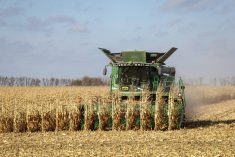Glacier FarmMedia – Off-target movement of herbicides carries a risk to your crops, the neighbour’s crop and insurance premiums.
With the arrival of Group 4 and Group 9 herbicide technologies, growers may think weed management is simpler. But resistant weed biotypes confound that notion and challenge growers and their advisors with tank-mix solutions and application timing.
Why it matters: Agronomists say industry and farmers need remedial training in off-target movement as seed technology and herbicide resistance increases.
Read Also

Still hard to predict precise fertilizer payback
Despite decades of advances, international research finds no clear answer for where and when adding nutrient will fail to boost growth.
The underlying factor in this scenario is off-target movement, where herbicides end up on crops outside the target field and result in poor neighbour relations and loss of yield for crops intolerant of the spray.
Chad Anderson, a certified crop advisor with Anderson Agronomy Services in Ontario, has been calling attention to this issue for years. Instead of differentiating between 2,4-D and dicamba, he identifies it as a Group 4 challenge.
“I worry that as Enlist acres increase, the incidence of dicamba drift will increase, since soybeans are so sensitive to it,” he said.
“Before, an Xtend grower need[ed to] be concerned about conventional soybeans next door. Now they will need to know if their neighbour is planting Enlist or Xtend, as well as be able to manage their applications.”
That means applying dicamba as early in the season as possible, when soybeans have yet to emerge or are just out of the ground.

Enlist technology is enticing to growers who want to wait until later to address fuller weed flushes. Yet this is where off-target movement increases the risk of more severe damage and crop loss, even though soybeans are more tolerant to 2,4-D than dicamba.
“The worst drift scenarios I have been involved with have been where conventional soybeans were initially hit with a dicamba drift and followed by a 2,4-D drift,” Anderson said.
He noted the issue was particularly severe with compounding dry conditions.
Definitions for everyone
Another part of the challenge is proper understanding of terms. Just as some in the industry use “varieties” and “hybrids” interchangeably, many find it hard to differentiate “drift” from “volatilization.”
Shannon Bieman believes everyone is confused about various terms.
“Absolutely, there’s not enough of an understanding,” said Bieman, a certified crop advisor with SeCan.
“We have to educate ourselves in the industry to do a better job of helping growers. We need to talk about the weather, sprayer tips, record keeping and having those conversations with neighbours. Ninety-nine per cent of growers want to get along, so we need to keep the lines open.”
Bieman took that challenge to heart by enrolling in Peter Sikkema’s weed science course last year. Among other things, she learned there are few days in a growing season without a thermal inversion. And she learned the fallacy of the statement, “I can spray; there’s no wind.”
Growers also need more information on optimal use of herbicide-tolerant seed technologies and should understand the “why” as much as the “what” of the purchase, she says.
“What chemistry do you need to address the problem? Is 2,4-D more important? What weed spectrum are you going after and why? This is no longer a variety issue.”
Anderson agreed that growers often miss important messages about chemical technology. For example, he noted, it’s troubling that some are unaware they’re required to spray dicamba with an extra- to ultra-coarse droplet size. This is an even greater concern in terms of liability insurance deductibles.
“Private insurance companies use your liability insurance to cover one field when they drift on another,” says Anderson. “The thing is, [the farmers] have to be negligent – making the application off-label, wrong tips, wrong wind direction or too windy, too calm.
“If you’re a multiple offender, you will see premiums rise but normally these policies carry no deductibles. This is starting to change because the amount of claims has become very worrisome.”
– This article was originally published at Farmtario.















